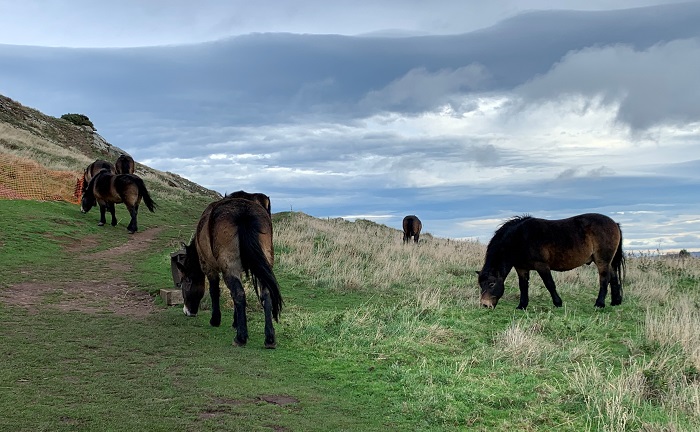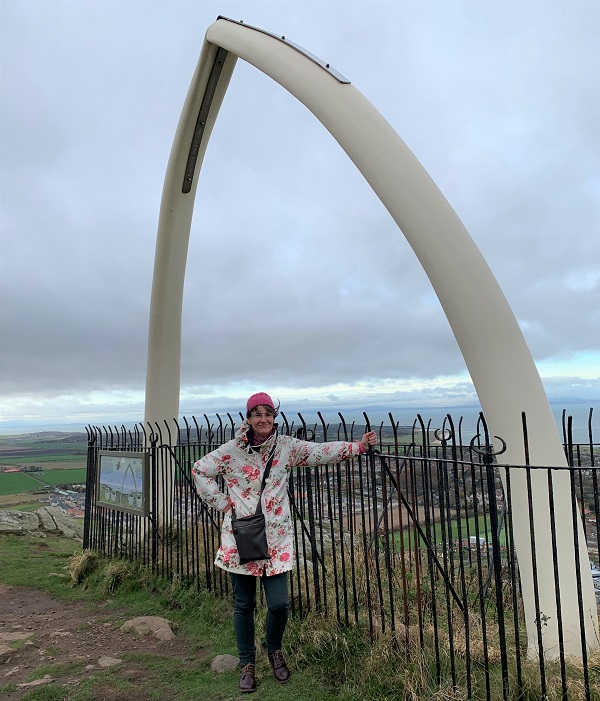
Have you ever tried ‘munro-bagging’? The idea is to climb one or all of the 282 Scottish mountains over 3000ft high (914m). I can’t say that’s ever been on our agenda. We love walking for exercise but prefer to saunter from place to place, or even in a circle, rather than climb up then down again. I blame this on two things. Firstly, although I can walk for hours on the flat, or even slightly undulating surface, I just seem to get annoyed and puffed out when I’m travelling vertically. Secondly, when you live, as we do, in The Fens, in a town which is only 4m above sea level, any incline can be seen as a challenge… though it was handy for not having to do a hill-start in my driving test.
On our trip to Edinburgh in November we couldn’t avoid an increase in gradient as the city, like Rome, is said to be built on seven hills. We therefore embraced the huffing and puffing and aching calves. Arthur’s Seat and Calton Hill are well-known to tourists and I’ve certainly heaved myself up them on previous visits. But as we were staying very close to Craiglockhart Hill, this member of the Magnificent Seven couldn’t be ignored. At 175m (574ft) it’s a tiddler when compared to the munros but as a spot to find some excellent views of Edinburgh, it was fantastic. A quick scoot round the edge of the golf course and we were there, on Wester Craiglockhart (the other peak, Easter Craiglockhart is slightly lower). The sun was low in the sky behind us, so we had the whole vista of the city and the Firth of Forth beyond.

When Rory joined us later that week we spent a Sunday morning exploring one of the other Edinburgh Hills that was on our doorstep: Blackford Hill. We chose a direct route to the summit via a set of steps which had me gasping momentarily. The boys tackled the incline with ease and much eye-rolling. It’s only 164m high (539ft) but the 360 degree views from the top were stunning. We could see the Braid Hills and Pentland Hills to the south west, we could wave to our new pal, Craiglockhart Hill, to the east and could easily spot Edinburgh Castle to the north. But the dominant feature of the view was the ancient volcano, Arthur’s Seat.

Towards the end of our two week break in Edinburgh, we drove out of the city to North Berwick. This seaside town is not to be confused with Berwick-upon-Tweed which is further south on the border with England. Dougie promised me a day of shopping, mooching, coffee and lunch stops. I dressed accordingly in flowery raincoat and ‘town boots’ rather than ‘hiking boots’. He didn’t tell me there was another bloomin’ hill in the vicinity.
You can’t miss the conical hill, North Berwick Law, overlooking the town. The word ‘law’ is the Scots term for a rounded hill and this one is decidedly round. It was formed from a volcanic plug 350 million years ago. Molten lava erupted then cooled and the shape is now known as a ‘crag and tail’. It looked huge to me but in fact is only 187m high (614ft). Dougie led me deftly away from the High Street and soon I was looking at the sign at the bottom of the hill telling me the 30 minute route to the summit had been taken by people for over 3000 years. I guessed some of them probably didn’t have appropriate footwear either so I gamely accepted the challenge.
It was a shame about the wind. My god, it was blowing hard that day. I could have done with some wickable layers and sturdy soles. But me and my flowery coat carried on, passing the hardy Exmoor ponies grazing on the lower paths. I’m not entirely sure how Exmoor ponies have found a home here: maybe they took the wrong turning on a Land’s End to John o’ Groats charity walk?

Thankfully, with the wind nearly knocking me off my feet, at the top of the hill there are things to hang onto. There’s an old telegraph station erected during the early 19th century to monitor sea lanes during the Napoleonic War and an observation post to keep watch on the mouth of the Forth for ships and aircraft during World War I and II. And, most impressive of all, a whale bone arch. There’s been a whale bone arch on North Berwick Law since 1709. I don’t know why. The current one is made of fibreglass, a cast of the previous incumbent.

The views were wonderful and yes, worth the effort. It was good to see Bass Rock, a whitish island in the sea. It’s white for most of the year because of the gannets and their guano: it has the largest population of northern gannets in the world with 75,000 nesting pairs. That creates a lot of poo.
North Berwick Law is also the place where you can spot kestrels. I couldn’t believe my luck when I snapped a photo of Dougie at the foot of the hill and the indigenous bird photo-bombed at just the right time.

I took several photos that day to remind me that I did actually climb the hill and survived, despite my urban footwear and gale force gusts. Posting them on Facebook, I remarked that it was a ‘big hill’. Scottish friends guffawed at this: big hill indeed! Time to slink back to the flat old Fens I think.



Leave a Reply